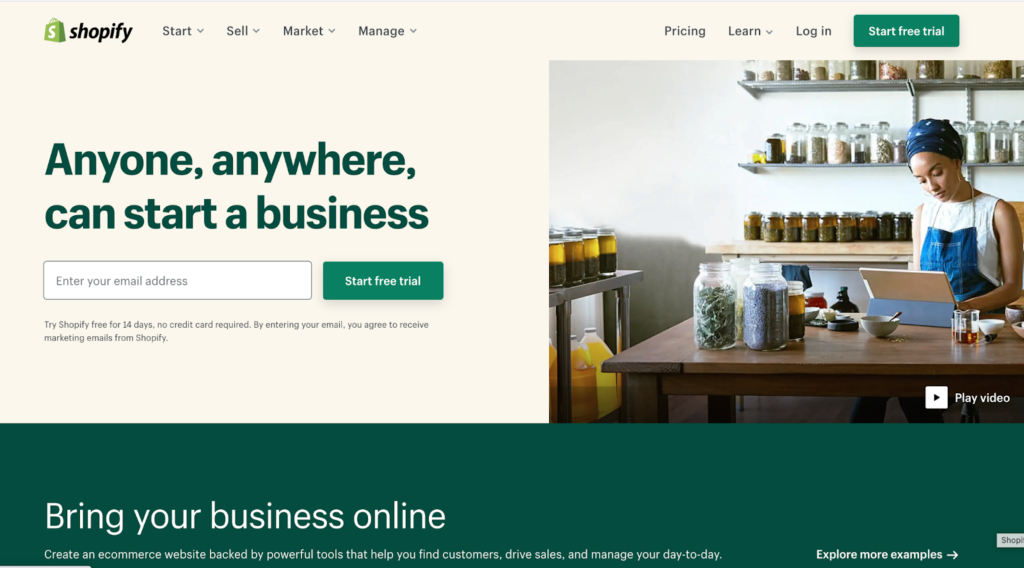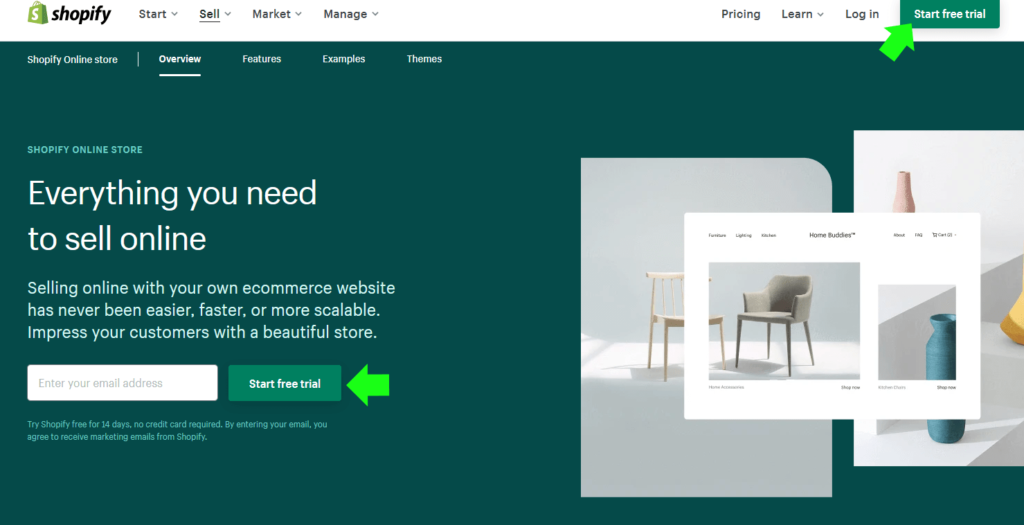Imagine the power of a platform if nearly every entrepreneur thinks of starting there to open their dream business and sell globally in an instant. That’s Shopify for you.
You can’t not know about this amazing eCommerce platform if you’ve ever thought of opening an online business. After all, it has the broadest range of sales tools and templates, is user-friendly and cloud-based, and is suitable for all sizes of businesses.
But what exactly is Shopify, and how does it work? You’ve heard your friends talk about it, watched that one random YouTube video, and read a few blogs. But now you want to know more.
Well, you’re at the right place.
What Exactly Does Shopify Do?
Shopify is a commerce platform that lets you set up an online store to sell your products.
It has been designed for businesses of all sizes to sell anything and everything that’s socially acceptable in society. You can sell physical products, dropshipped products, digital products, or services…really anything that isn’t illegal or shady.
You get everything you would need to build and market your online store, including templates, a payment processor, email marketing tools, a blog, and so on. Customizing the site so that it meets your individual requirements is also possible.
Shopify is a hosted solution, which means that the platform runs on its own servers. You don’t have to buy any web hosting or install any software anywhere.
You simply have to pay a monthly fee to use the platform, and as long as you have access to a web browser and the internet, you can manage your store from anywhere.
Who Should Use Shopify?
Shopify is for everyone who wants to become a part of the eCommerce niche.
You can sell anything from bike saddles to doormats to temporary tattoos to hair styling tools and accessories to motor-vehicle upholstery here. Yes, you can get that specific too. But it’s not a marketplace like Etsy, Amazon, or eBay.
There are all kinds of companies—from Kylie Cosmetics and Homegrown Meats to Water Aid and Tesla—who trust this platform to reach out to and serve customers.
It’s best for people who want to run their businesses online and offline and want to reach out to new customers. So, there really are no clear-cut rules about who can join Shopify.
To give you more clarity, though, I’ll tell you about the other things you can sell on Shopify that aren’t physical products.
- Services. You can add an appointment booking feature to your Shopify store. This can come in handy for sellers who offer customization in clothing, furniture, jewelry, and beyond to create the desired products.
- Memberships. You can sell memberships to customers on Shopify, which can then be used for physical businesses or for managing member-only access to content on websites.
- Digital Products. You can offer original creative course content on the platform. Customers will receive the file or a downloadable link to the file after they make a purchase.
- Rentals. You can rent out physical products for a predetermined amount of time. This can help customers who need a product for one-time use or those who don’t have the money to own the product.
- Consultations and Classes. You can sell your time on Shopify—provided it’s in the form of training or guidance. This includes people who offer in-person consultation along with physical products like fitness trainers and interior designers. Selling classes, lessons, and workshops are also possible.
The above are just a few examples of things that can be sold on Shopify. As you can see, the platform is literally for anyone who wants to build an eCommerce store by using its templates and sales tools without any extra hassle or expense.
Who Should NOT Use Shopify?
Like two sides of a coin, the advantages of Shopify are accompanied by its fair share of limitations. Due to this, it’s possible for the platform to not be the right fit for you in specific cases. Here are a few:
Case 1: When You Want Highly Detailed Site Customization
You can upload your store logo, choose your colors and fonts, and attractively present your products and services. But if you want more customization than that, you’ll have to either hire a Shopify designer or learn how to code yourself.
In other words, Shopify has limited customization features.
If you want custom fonts, control the display of your product pages, or other similar tasks to have control over your store’s design, Shopify isn’t for you.
And coding isn’t necessarily a way around this issue. You can always learn Liquid, which is Shopify‘s own language used for themes, if you really want to. But even if you do, you can’t simply head to Google to solve issues in Liquid the way you could if Shopify used a standard programming language like PHP.
If customizing Shopify is that important to you, you can hire a developer that specializes in Shopify—provided you have the budget for it.
Speaking of budget…
Case 2: When You Have a Small Budget
Shopify themes are expensive. Shopify apps are expensive. Shopify itself is expensive.
Its basic plan is almost useless as it lacks some crucial features like analysis, reports, and real-time shopping rate. The cheapest plan starts at $9 per month, and while this may seem affordable at first glance, you’ll soon realize launching your eCommerce business with Shopify is definitely not a cheap affair if you start digging deeper.
You have to shell out extra cash for the transaction fees, credit card processing fees, purchasing and installing apps, among others. Plus, there are only 71 themes in the official theme store, which can cost anything between $140-$180.
So if you’re trying to avoid spending money, Shopify is not the best option for you.
Case 3: When Shopify is Only a Stop, Not Your Destination
As mentioned before, Shopify is a hosted platform.
While this is great since all the technical details like finding a hosting platform, installing software, and getting an SSL certificate are taken care of, you face the risk of losing your Shopify store if the platform ever decides to close its doors or to penalize you.
And not only that, even migrating your store isn’t easy. All you’ll get is a CSV of your products—everything else has to be recreated from scratch.
How Shopify Works
Shopify has many things going for it. It works as a software-as-a-service (SaaS) tool that can be used by anyone. It has a simple set-up process. All you have to do is pick a theme, customize information, add the products you want to sell, specify payment options, and finally, go live.
In this section, I’ll elaborate on the different tools and perks the platform offers that can be fantastic for eCommerce sellers. Let’s take a quick look:
Automatic Order Features
A Shopify shopping cart can automatically calculate shipping rates and taxes while giving you the option of ordering flat-rate or free shipping at the price point to choose from. The idea here is to help you provide an enhanced customer experience to your customers.
Secure Payments
Shopify allows you to accept payments in different ways. You can use the platform’s proprietary gateway, Shopify Payments, as well as third-party payment gateways for an additional fee. The good news is that all your payments are secure with a free SSL certificate.
Marketing Features
Shopify offers tons of marketing features to take your experience to another level.
For instance, you can use Shopify tools to group your ideal customers by category. This can be useful for creating targeted marketing campaigns. The other feature is called the abandoned checkout recovery.
Whenever a customer abandons their shopping cart before checkout, Shopify automatically sends them reminder emails in a bid to entice them back to the items they almost purchased. Social media integration, built-in blog features, and customizable automated email templates are also available.
Product Handling
You can get rid of time-consuming and costly activities like storing, packaging, and shipping products with Shopify.
- Drop Shipping: It integrates with Oberlo, which is an online marketplace where you can find products to sell from all over the world. If you opt for the drop shipping facility, you simply have to display and sell their products, while the dropshipper will take care of your delivery.
- Third-Party Fulfillment Centers: Shopify has fulfillment agreements with eBay, Rakuten, and Amazon. You can arrange for your inventory to be delivered to their fulfillment centers, where they’ll store your products and even ship them with your labeling.
Extra Charges
You have to choose from the available monthly payment plans to use Shopify. You’ll also incur credit card fees for every transaction, with varying fee amounts depending on the plan you choose. As your business grows, you can add services and lower transaction costs by upselling, which is very useful for ambitious entrepreneurs.
For instance, if you use third-party payment systems, the additional charges will be 2% for Basic Shopify, 1% for Shopify, and 0.5% for Advanced Shopify.
What I Wish I Knew Before Starting My First Shopify Store
You’ll learn several lessons once you embark on your Shopify journey just like I did. However, to ensure you don’t make the same mistakes as I did, here are some of the things I wish I knew to make my journey smoother.
Lesson #1: Always Choose Functionality Over Design
I’m not claiming that my first Shopify store was the most visually attractive site, but I did everything I could to make my website beautiful and cool when starting out.
That was my first mistake.
Having a pretty website wasn’t something that would help me make money. Instead, what my visitors really cared about was usability. They wanted a website that they could trust.
I soon realized my folly and shifted focus from having a gorgeous design to navigability. I prioritized making it easy for people to visit my Shopify store, find what they want and add it to their cart, fill in their payment information—basically, everything that could help enhance their experience.
Lesson #2: Getting People to Come to Your Store is HARD
The whole point of launching an eCommerce store is to make money, but you really can’t succeed if you don’t have customers.
The catch? Getting people to visit your store is anything but easy.
I was under the impression that since I knew the SEO basics and had launched paid campaigns, I had taken care of that.
That was my second mistake.
Choosing an advertisement channel is important for generating enough buzz for your store. But instead of launching campaigns for every single channel, it’s better to focus (and succeed!) on either one or two.
I got this part right. However, what I messed up was with the budget. I ended up making a substantial upfront investment without truly understanding the ins and outs of paid ads.
Eventually, I created a different funnel for generating quality leads—not boosting sales, mind you—and saw better results. This also helped lower my acquisition costs which worked in my favor in the long run.
Lesson #3: Don’t Skip Mobile Optimization
I didn’t have to worry too much about how my website looked thanks to Shopify’s amazing website design tool. But it was getting the mobile version right which was trickier for me.
The platform itself will indeed tweak things to make your website more mobile-friendly, but it isn’t enough.
I didn’t know that, and that was my third mistake.
Considering that 8 out of 10 people won’t continue browsing your website if it isn’t displayed properly on their device, this isn’t something that you should take lightly.
I realized that while my CTA buttons looked appropriate on the website, it was smaller for the mobile. I also tweaked my content to show as little text as possible and make the images the center point.
Additionally, I optimized for different screen ratios, minimized the number of pop-ups, and fixed the main header too. While it took time, I was soon able to lock in more mobile traffic.
With the what-to-do and what-not-to-do out of the way, let’s focus on actually starting your Shopify shop.
How to Get Started with Shopify
Here’s a step-by-step walkthrough of how you can start your very own first Shopify store.
Step 1: Sign up for the Free Trial
You can avail of a 14-day free trial with Shopify. This will give you enough time to get used to the platform and test out the features before making any real commitment.
The even better news? You don’t have to give any credit card information—just basic information like your store name, email address, and so on is enough. Once you complete everything, you’ll get access to Shopify’s marketplace.
Step 2: Add the Products You Want to Sell
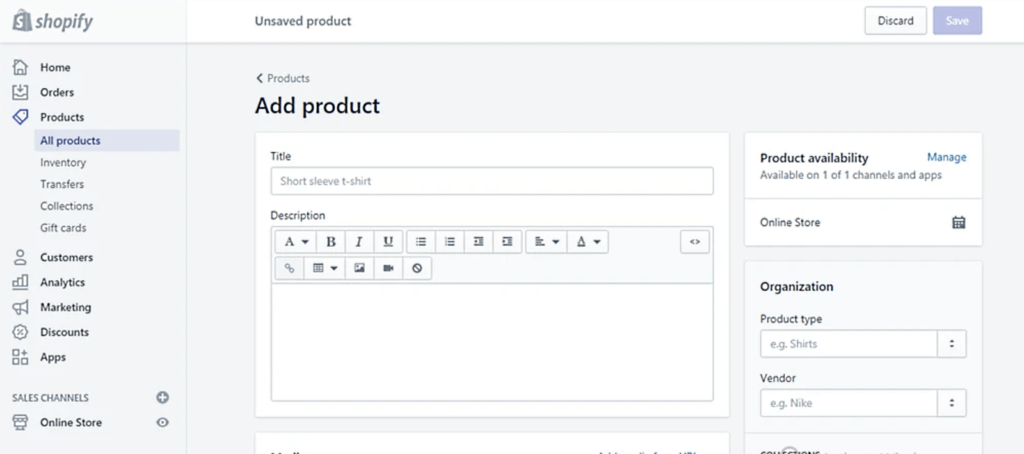
Before adding the products, you have to figure out the products you want to sell on Shopify. This is an exciting process as you get to take all the creative decisions related to your eCommerce store.
There are hundreds of products and services you can sell on Shopify, but you know that already.
The important thing here is for you to have your own product idea and then work on getting those products. Follow this up by adding the products to your website.
Click on Products and then All Products to include as many details you want. This is where your customers will learn about your product and decide whether to buy it or not. Make sure you upload high-quality and clear product images that help highlight its special features as well.
Once everything is done, click on Save Product to save the changes.
Step 3: Customize Your Store With Themes

When choosing a theme, keep in mind that is exactly how your website would look to your visitors. So getting the aesthetics right is crucial here.
Go to Online Store, and click on Themes. You’ll find all kinds of themes—free and premium—in the Shopify Theme Store. While each one of them is well-designed, mobile-friendly, and highly responsive, you can also pick one from third-party marketplaces like ThemeForest.
Once you find a theme to your liking, click on Add Theme, and then Customize in Theme Manager to start editing your webpage.
Step 4: Sort Your Shipping Details
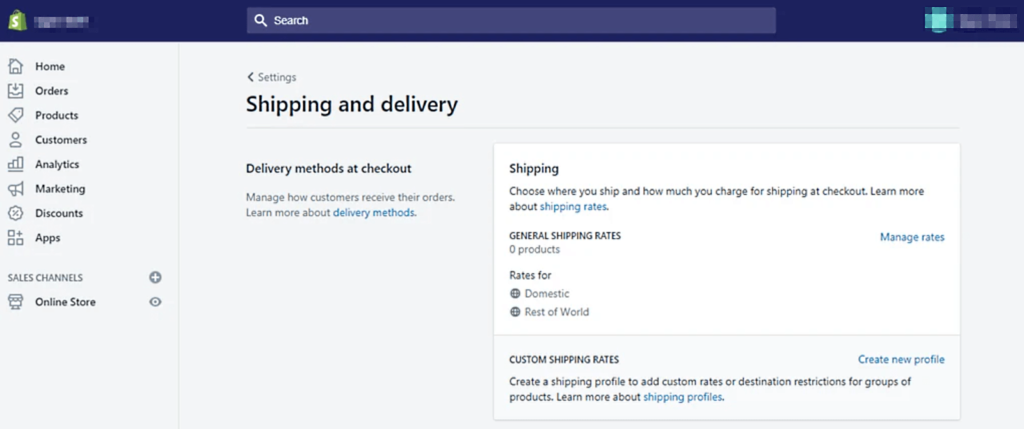
Getting the shipping details accurate is important for every eCommerce store. They must be calculated based on your product weights, packaging, carriers, locations, profit margin per order, and more.
Go to Settings and then Shipping and Delivery. All you have to do here is set your preferred shipping rules. You can choose Shopify Shipping or any other third-party provider—it’s completely up to you.
Step 5: Enable Payments to Your Store
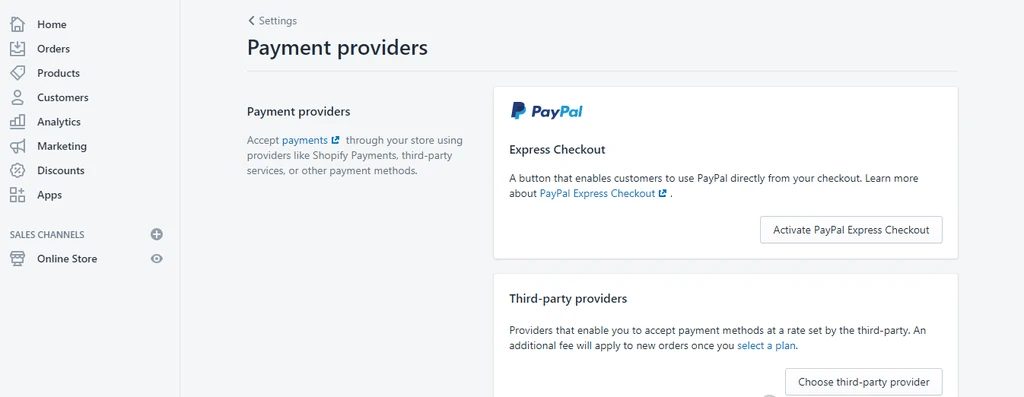
You can receive payments from customers through your website thanks to Shopify’s payment gateways. Just make sure you choose the right payment gateway after considering prices, commissions, and features.
Click on Settings, followed by Payments, to set your payment options. You’ll find two choices here: Shopify Payments or Third-party payment providers (PayPal, Amazon Pay, etc.).
My tip? Enable both options.
This will help you appear more trustworthy and dependable in your visitor’s eyes without having to spend an extra dime. It’s really a win-win.
from Quick Sprout https://ift.tt/3fjAyDP
via IFTTT
